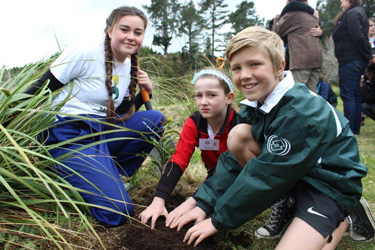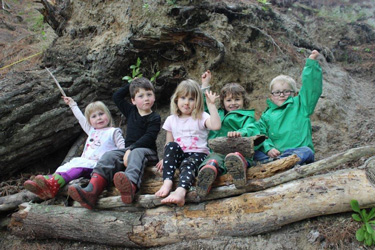The Conservationists
Kids Greening Taupō is a conservation education programme that is bringing bio-diversity back to the town, but unlike other community-run projects, it is the children of Taupō who are running the show.
Based on the ‘Kids Restore the Kepler’ project in Te Anau, which has successfully reduced the number of pests and brought back many species that were close to extinction, Kids Greening Taupō shares the same approach as the Fiordland project with its strong emphasis on youth involvement and leadership.
Tania Wells is the Department Of Conservation’s (DOC) local ranger and has been instrumental in getting Kids Greening Taupō off the ground.
“A group travelled to Te Anau to see how the Kepler project was run and how they worked collaboratively,” says Tania. “Following that visit, a local working group was set up comprising representatives from Greening Taupō, Tauhara College, Tūwharetoa Māori Trust Board and DOC.”
The project become a reality in late 2014, with an 18 month pilot programme now running and involving two kindergartens, two primary schools and one college. Earlier this year an education co-ordinator was appointed, funded by DOC locally. Additional funding for a further two years has been secured through the DOC Community Conservation Partnership Fund.
“We started conversations with schools and funding groups around using conservation as a context for learning. Next we recruited schools and it was evident there was a huge thirst for this type of programme. We are running the pilot programme with five schools initially and the hope is it will be replicated throughout the country,” adds Tania.
The student-led programme is aligned with the work of Greening Taupō, a community organisation that aims to increase the native flora and fauna of the town for the benefit of its people, businesses and natural environment. Kids Greening Taupō provides the link between local schools and Greening Taupō, where students are actively involved with conservation projects to increase native bird life as well as solving real life environmental problems.
“The important thing about Kids Greening Taupō is kids are actually running the programme,” says seven year-old Tajshan Ram from Taupō Primary School and a member of the student leadership team.
“We make some of the decisions. Not the adults. We vote for things we need to decide on because we work together as a team,” he says.
Each school has taken on a specific green or environmental project, as Tania explains. “One school has eco-sourced kowhai seed and planted them up to seedling stage, which we’ll then take and plant kowhai throughout their school and the region. I should mention planting is not restricted to using only native species. A local ecologist highlighted the benefits of also using non-local trees like eucalypt [flowering gum] that provide food for birds over winter.”
“Four Seasons and Hinemoa kindergartens are connecting students to nature by going into the bush each week for an entire day. These ‘bush kindergartens’ enable children to witness changes in the seasons, learn about plants and how their natural environment works. For one day a week, story time on the mat takes on a new meaning!”
Teacher education is a priority, with seven workshops having been held to date to ensure teachers are confident in the skills and techniques required for a conservation education programme. One workshop was held at the Taupō Native Plant Nursery, teaching harvesting, propagating, planting and dividing, and another at the Botanic Gardens to show how trap- lines work. “Teaching the teachers to teach the children is vital,” says Tania.
Kids Greening Taupō extends well beyond planting and weeding, and ‘green fingers’ are not a pre-requisite for participation.
“Any skills can grow conservation regardless of gardening prowess. Students can contribute in a number of ways including I.T. (computer) skills to develop the website and social media, storytellers to populate the blog and graphic designers. These children may not be planting trees, but that’s how we are getting this project across the school curriculum.”
Waipahihi Primary pupil Alana French says that the work Greening Taupō does is important for a healthy environment.
“We are bringing back the native birds by creating lots of green nature spaces. We might be kids now but when we are grown up we want our kids to be able to see real live Kiwi, kea, kereru and Tui. We need to help nature along. Because when the birds are gone they are gone forever,” she says.
A unique difference between the Kepler and Taupō projects is the involvement of local Iwi in the latter, who provide guidance and support.
“Having Iwi involved means we are able to learn traditional ways of planting and harvesting and we get local stories and the Māori perspective on conservation,” explains Tania.
“For example we held a professional development session for teachers at a local marae to learn the correct way to harvest harakeke flax. A flax bush is a ‘family’ and as such when it’s harvested it must be cut on a certain angle to protect the ‘babies’. We also learnt how to use left-over flax to form a simple flax band that we can use instead of plastic covers to protect newly planted or young trees. To have this cultural understanding is bringing huge value to the project.”
Already there is high demand from other schools around the country to be involved in a similar programme. It’s an exciting time ahead for the team. Taupō Primary School teacher Karen Watson says: “Through environmental education we are giving children the knowledge and skills to make a difference.”
10-Nov-2015


Students attending bush kindergarten

